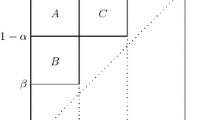Abstract
This paper studies multilateral trading problems in which agents’ valuations for items are interdependent. Assuming that each agent’s information has a greater marginal effect on her own valuation than on the other agents’ valuations, the paper identifies a necessary and sufficient condition for the existence of trading mechanisms satisfying efficiency, ex-post incentive compatibility, ex-post individual rationality, and ex-post budget balance. The paper presents a trading mechanism that satisfies the four properties when the necessary and sufficient condition holds and shows that this mechanism maximizes the ex-post budget surplus among all efficient, ex-post incentive compatible, and ex-post individually rational trading mechanisms. The paper examines an environment where each agent can possess at most one unit of an item, and her information about the item is one-dimensional. It then extends the results to two general environments: the multiple units environment and the multidimensional information environment.

Similar content being viewed by others
Data availability
No datasets were generated or analyzed in this work.
Notes
Bilateral trading is trading between one buyer and one seller, and multilateral trading is the generalization of bilateral trading to m buyers and n sellers where m, n are arbitrary positive numbers.
The definition of EPBB in this paper allows a positive budget surplus.
The interdependent values model includes the private values model as a special case.
This definition is well-defined because \(| \{b_i\in B\mid v_{b_i}(t)>v_{(m+1)}(t)\} | \le |\{s_j\in S\mid v_{s_j}(t)\le v_{(m)}(t)\}|\) and \(|\{s_j\in S \mid v_{s_j}(t)< v_{(m)}(t)\}| \le | \{b_i\in B \mid v_{b_i}(t)\ge v_{(m+1)}(t)\} |\) for each \(t\in T\).
See “Appendix 2” section for the proof.
By abuse of notation, I define \(\sum _{q=1}^{\pi _k(t')}v_k^q(t)=0\) if \(\pi _k(t')=0\).
For simplicity of exposition, I assume \({\hat{t}}_{b_i}^q(t_{-b_i})>{\underline{t}}_{b_i}\) for all \(q=1,\ldots ,\pi _{b_i}(t)\). However, allowing \({\hat{t}}_{b_i}^q(t_{-b_i})={\underline{t}}_{b_i}\) for some q does not affect the main argument of the proof.
References
Andreyanov P, Sadzik T (2021) Robust mechanism design of exchange. Rev Econ Stud 88(2):521–573. https://doi.org/10.1093/restud/rdaa049
Chung K-S, Ely JC (2006) Ex-post incentive compatible mechanism design. Discussion Paper, Northwestern University.https://citeseerx.ist.psu.edu/viewdoc/download?doi=10.1.1.121.8204 &rep=rep1 &type=pdf
Dasgupta P, Maskin E (2000) Efficient auctions. Quart J Econ 115(2):341–388. https://doi.org/10.1162/003355300554755
Fieseler K, Kittsteiner T, Moldovanu B (2003) Partnerships, lemons, and efficient trade. J Econ Theory 113(2):223–234. https://doi.org/10.1016/S0022-0531(03)00109-1
Jantschgi S, Nax HH, Pradelski B, Pycia M (2023) Double auctions and Walrasian equilibrium. Working paper no. 404, Department of Economics, University of Zurich. https://papers.ssrn.com/sol3/papers.cfm?abstract_id=4043532
Jehiel P, Meyer-ter-Vehn M, Moldovanu B, Zame WR (2006) The limits of ex post implementation. Econometrica 74(3):585–610. https://doi.org/10.1111/j.1468-0262.2006.00675.x
Jehiel P, Moldovanu B (2001) Efficient design with interdependent valuations. Econometrica 69(5):1237–1259. https://doi.org/10.1111/1468-0262.00240
Kojima F, Yamashita T (2017) Double auction with interdependent values: incentives and efficiency. Theor Econ 12(3):1393–1438. https://doi.org/10.3982/TE2275
Krishna V (2009) Auction theory, 2nd ed. Academic Press, London. https://shop.elsevier.com/books/auction-theory/krishna/978-0-12-374507-1
Krishna V, Perry M (1998) Efficient mechanism design. Discussion paper, Penn State University. https://doi.org/10.2139/ssrn.64934
Maskin E (1992) Auctions and privatization. In: Siebert H (ed) Privatization, pp 115–136.https://scholar.harvard.edu/maskin/publications/auctions-and-privatization
McAfee RP (1992) A dominant strategy double auction. J Econ Theory 56(2):434–450. https://doi.org/10.1016/0022-0531(92)90091-U
McLean R, Postlewaite A (2015) Implementation with interdependent valuations. Theor Econ 10(3):923–952. https://doi.org/10.3982/TE1440
Myerson R, Satterthwaite M (1983) Efficient mechanisms for bilateral trading. J Econ Theory 29(2):265–281. https://doi.org/10.1016/0022-0531(83)90048-0
Reny P, Perry M (2006) Toward a strategic foundation for rational expectations equilibrium. Econometrica 74(5):1231–1269. https://doi.org/10.1111/j.1468-0262.2006.00703.x
Rustichini A, Satterthwaite M, Williams S (1994) Convergence to efficiency in a simple market with incomplete information. Econometrica 62(5):1041–1063. https://doi.org/10.2307/2951506
Williams S (1999) A characterization of efficient, Bayesian incentive compatible mechanisms. Econ Theor 14:155–180. https://doi.org/10.1007/s001990050286
Williams S, Radner R (1988) Informational externalities and the scope of efficient dominant strategy mechanisms. Discussion paper no. 761, Northwestern University. https://ideas.repec.org/p/nwu/cmsems/761.html
Wilson R (1987) Game-theoretic analyses of trading processes. In: Bewley T (ed) Advances in economic theory: fifth world congress. Cambridge University Press, Cambridge, pp 33–70. https://doi.org/10.1017/ccol0521340446.002
Acknowledgements
I thank the Editor, the Associate Editor, and two anonymous referees for comments that led to improvements in this paper. I am also grateful to Steven Williams, Dan Bernhardt, Jorge Lemus, Guillermo Marshall, and Bei Yang for their comments and suggestions.
Author information
Authors and Affiliations
Corresponding author
Additional information
Publisher's Note
Springer Nature remains neutral with regard to jurisdictional claims in published maps and institutional affiliations.
Appendices
Appendix 1: Stochastic allocation
The definition of EF of the mechanism \((\pi , \tau )\) with stochastic allocation is as follows: For each \(t\in T\), \(b_i\in B\), and \(s_j\in S\), if \(v_{(m)}(t)<v_{(m+1)}(t)\),
If, however, \(v_{(m)}(t)=v_{(m+1)}(t)\),
satisfying \(\sum \nolimits _{b_i\in B}\pi _{b_i}(t)=\sum \nolimits _{s_j\in S}\pi _{s_j}(t)\).
The following theorem provides the necessary and sufficient condition for the existence of mechanisms satisfying the four properties if stochastic allocation is allowed. Note that the condition in the theorem is equivalent to (2) if we restrict attention to deterministic allocation rules.
Theorem 1′
(Stochastic allocation) Suppose that (A1)–(A4) hold. There exists a multilateral trading mechanism satisfying EF, EPIC, EPIR, and EPBB if and only if for some EF allocation rule \(\pi\),
for each \(t\in T\).
Proof
\(\Rightarrow\): Suppose that \((\pi , \tau )\) satisfies EF, EPIC, EPIR, and EPBB. Consider \(t\in T\) and the non-trivial case that \(\{b_i\in B\,|\,\pi _{b_i}(t)>0\}\ne \emptyset\) and \(\{s_j\in S\,|\,\pi _{s_j}(t)>0\}\ne \emptyset\). Each \(b_i\in B\) falls under one of the following cases: (i) \(\pi _{b_i}(t)=1\) and \(t_{b_i}>{\hat{t}}_{b_i}(t_{-b_i})\), (ii) \(\pi _{b_i}(t)\in (0,1]\) and \(t_{b_i}={\hat{t}}_{b_i}(t_{-b_i})\), or (iii) \(\pi _{b_i}(t)=0\). If we repeat the argument in the proof of Theorem 1 and examine \(\tau _{b_i}(t)\) in each case, we have
I omit the remaining part of the proof because it is the same as the proof of Theorem 1.
\(\Leftarrow :\) Define the transfer rule \(\tau\) as follows: for \(b_i\in B\), \(s_j\in S\), and \(t\in T\),
\((\pi , \tau )\) satisfies EF, EPIC, EPIR, and EPBB by the same argument as in the proof of Theorem 1. \(\square\)
Appendix 2: Assumptions under private values
Proposition 1
Suppose that \(v_k(t)=t_k\) for all \(t\in T\) and \(k\in B\cup S\). Then, (A4) holds if and only if
Proof
\(\Rightarrow\): Suppose to the contrary that \(\bigcap _{k\in B\cup S}\,({\underline{t}}_k,{\overline{t}}_k)=\emptyset .\) Let \(k_1=\textrm{argmin}_{k\in B\cup S}\,\,{\overline{t}}_k\) and \(k_2=\textrm{argmax}_{k\in B\cup S}\,\,{\underline{t}}_k\). Then, \({\overline{t}}_{k_1}\le {\underline{t}}_{k_2}\). Thus, \(t_{k_1}<t_{k_2}\) for any \(t_{k_1}\in ({\underline{t}}_{k_1},{\overline{t}}_{k_1})\) and \(t_{k_2}\in ({\underline{t}}_{k_2},{\overline{t}}_{k_2})\). Therefore, (A4) does not hold.
\(\Leftarrow\): There exist \(x\in \bigcap _{k\in B\cup S}\,({\underline{t}}_k,{\overline{t}}_k)\) and \(\epsilon >0\) such that \((x-\epsilon , x+\epsilon ) \subset ({\underline{t}}_k,{\overline{t}}_k)\) for all \(k\in B\cup S\). Let \(\sigma\) be a permutation of \(B\cup S\). Consider \((\epsilon _k)_{k\in B\cup S}\) satisfying \(0<\epsilon _{b_1}<\epsilon _{b_2}<\cdots<\epsilon _{b_m}<\epsilon _{s_1}<\cdots<\epsilon _{s_n}<\epsilon\). Define \(t_{\sigma (k)}=x+\epsilon _k\) for \(k\in B\cup S\). Then, \(t_{\sigma (k)}\in ({\underline{t}}_{\sigma (k)},{\overline{t}}_{\sigma (k)})\) for all \(k\in B\cup S\) and \(t_{\sigma (b_1)}<\cdots<t_{\sigma (b_m)}<t_{\sigma (s_1)}<\cdots <t_{\sigma (s_n)}\). \(\square\)
Appendix 3: Multiple units
1.1 Definitions of EPIC, EPIR, EPBB, and EF
A mechanism \((\pi , \tau )\) is EPIC if
A mechanism \((\pi , \tau )\) is EPIR if
A mechanism \((\pi , \tau )\) satisfies EPBB if
A mechanism \((\pi , \tau )\) is EF if it allocates the nQ items to the nQ highest marginal values or costs: For each \(t\in T\), we order the agents’ marginal values and costs.
If \(v_{(mQ)}(t) < v_{(mQ+1)}(t)\), for \(b_i\in B\) and \(s_j\in S\),
If \(v_{(mQ)}(t) = v_{(mQ+1)}(t)\), for \(b_i\in B\) and \(s_j\in S\),
satisfying \(\sum \nolimits _{b_i\in B}\pi _{b_i}(t) = \sum \nolimits _{s_j \in S}\pi _{s_j}(t).\)
1.2 Proof of Theorem 5
The following lemma derives the necessary condition for EPIC when agents can trade multiple units. I omit the proof as it is similar to the proof of Lemma 1.
Lemma 2
Suppose that a mechanism \((\pi , \tau )\) satisfies EPIC. Then:
-
(i)
for any \(b_i\) and \(t_{-b_i}\), \(\tau _{b_i}(t_{b_i},t_{-b_i}) = \tau _{b_i}(t_{b_i}',t_{-b_i})\,\,\,\) if \(\,\pi _{b_i}(t_{b_i},t_{-b_i})=\pi _{b_i}(t_{b_i}',t_{-b_i})\), and
-
(ii)
for any \(s_j\) and \(t_{-s_j}\), \(\tau _{s_j}(t_{s_j},t_{-s_j}) = \tau _{s_j}(t_{s_j}',t_{-s_j})\,\,\,\) if \(\,\pi _{s_j}(t_{s_j},t_{-s_j})=\pi _{s_j}(t_{s_j}',t_{-s_j})\).
Proof of Theorem 5
\(\Rightarrow\): Suppose that a mechanism \((\pi , \tau )\) satisfies EF, EPIC, EPIR, and EPBB. Consider \(t\in T\). Each buyer \(b_i\) falls under one of the following two cases: (i) \(\pi _{b_i}(t)>0\) or (ii) \(\pi _{b_i}(t)=0\). We examine \(\tau _{b_i}(t)\) in each case.
(i) \(\pi _{b_i}(t)>0\): For \(q=1,\ldots ,\pi _{b_i}(t)\), the definition of \({\hat{t}}_{b_i}^q(t_{-b_i})\) and the decreasing marginal values, (A4\(^{\prime }\)), imply \(v_{b_i}^q({\hat{t}}_{b_i}^q(t_{-b_i}), t_{-b_i}) = v_{(mQ+1)}({\hat{t}}_{b_i}^q(t_{-b_i}),t_{-b_i})\) and \(v_{b_i}^{q+1}({\hat{t}}_{b_i}^q(t_{-b_i}), t_{-b_i}) < v_{(mQ+1)}({\hat{t}}_{b_i}^q(t_{-b_i}),t_{-b_i})\).Footnote 8 For sufficiently small \(\epsilon >0\), the single-crossing condition, (A3\(^{\prime }\)), implies \(v_{b_i}^q({\hat{t}}_{b_i}^q(t_{-b_i})+\epsilon , t_{-b_i}) > v_{(mQ+1)}({\hat{t}}_{b_i}^q(t_{-b_i})+\epsilon ,t_{-b_i})\) or \(v_{b_i}^q({\hat{t}}_{b_i}^q(t_{-b_i})+\epsilon , t_{-b_i}) = v_{(mQ+1)}({\hat{t}}_{b_i}^q(t_{-b_i})+\epsilon ,t_{-b_i}) > v_{(mQ)}({\hat{t}}_{b_i}^q(t_{-b_i})+\epsilon ,t_{-b_i})\), and the continuity of \(v_k^q\), (A1\(^{\prime }\)), implies \(v_{b_i}^{q+1}({\hat{t}}_{b_i}^q(t_{-b_i})+\epsilon , t_{-b_i}) < v_{(mQ+1)}({\hat{t}}_{b_i}^q(t_{-b_i})+\epsilon ,t_{-b_i})\). Thus, we have
because \(\pi\) is an efficient allocation rule. Consider sufficiently small \(\epsilon >0\) such that (18) holds for all \(q=1,\ldots ,\pi _{b_i}(t)\). EPIR at \(({\hat{t}}_{b_i}^1(t_{-b_i})+\epsilon ,t_{-b_i})\) implies
Plugging (18) into (19) leads to
For \(q=2,\ldots ,\pi _{b_i}(t)\), EPIC at \(({\hat{t}}_{b_i}^{q}(t_{-b_i})+\epsilon ,t_{-b_i})\) with misreport \({\hat{t}}_{b_i}^{q-1}(t_{-b_i})+\epsilon\) implies
Plugging (18) into (21) leads to
If we add (22) for \(q=2,\ldots ,\pi _{b_i}(t)\), and (20), we have
Because \(\pi _{b_i}({\hat{t}}_{b_i}^{\pi _{b_i}(t)}(t_{-b_i})+\epsilon ,t_{-b_i})=\pi _{b_i}(t)\) from (18), Lemma 2 implies
Thus, from (23) and (24), we have
This inequality holds for any sufficiently small \(\epsilon >0\). Therefore, by the continuity of \(v_{b_i}^q\),
(ii) \(\pi _{b_i}(t)=0\): EPIR implies
By adding up inequalities (25) and (26) for all \(b_i\in B\), we have
If we repeat the same argument for the sellers, we have
Thus, (27), (28), and EPBB imply
\(\Leftarrow :\) Suppose that (14) holds for each \(t\in T\) for some EF allocation rule \(\pi\). Define the transfer rule \(\tau\) as follows: for \(b_i\in B\), \(s_j\in S\), and \(t\in T\),
If t is a reported type profile, according to the mechanism, buyer \(b_i\) purchases \(\pi _{b_i}(t)\) units of the item and pays \(v_{b_i}^q({\hat{t}}_{b_i}^q(t_{-b_i}), t_{-b_i})\) for the q-th unit. Similarly, seller \(s_j\) sells \(\pi _{s_j}(t)\) units and receives \(v_{s_j}^q({\hat{t}}_{s_j}^q(t_{-s_j}), t_{-s_j})\) for the q-th unit. Note that the price of the q-th unit for agent \(k\in B\cup S\), \(v_k^q({\hat{t}}_k^q(t_{-k}),t_{-k})\), does not depend on her report \(t_k\).
The mechanism \((\pi , \tau )\) defined above is the multi-price mechanism for the multiple units environment. It satisfies EPIC and EPIR. Consider buyer \(b_i\in B\). The definition of \({\hat{t}}_{b_i}^q(t_{-b_i})\), EF of \(\pi\), and (A1\(^{\prime }\))–(A4\(^{\prime }\)) imply
Suppose that t is a profile of agent types, \(b_i\) reports \(t_{b_i}'\), and the other agents report \(t_{-b_i}\). Then, \(b_i\)’s ex-post payoff is
which is the sum of the payoffs from trading \(\pi _{b_i}(t'_{b_i},t_{-b_i})\) units. We note the following from (29): Up to \(\pi _{b_i}(t)\) units, \(b_i\) obtains a non-negative ex-post payoff from trading each unit. However, starting from the \((\pi _{b_i}(t)+1)\)-th unit, \(b_i\) obtains a non-positive payoff from trading each unit. Thus, \(b_i\) maximizes her ex-post payoff, (30), by trading \(\pi _{b_i}(t)\) units, which occurs when she reports her type truthfully—that is, \(t'_{b_i}=t_{b_i}\). I omit the proof of EPIC and EPIR for the sellers, as it is similar to the one for the buyers. \((\pi , \tau )\) also satisfies EPBB because
\(\square\)
Rights and permissions
Springer Nature or its licensor (e.g. a society or other partner) holds exclusive rights to this article under a publishing agreement with the author(s) or other rightsholder(s); author self-archiving of the accepted manuscript version of this article is solely governed by the terms of such publishing agreement and applicable law.
About this article
Cite this article
Kim, K. On the existence of efficient multilateral trading mechanisms with interdependent values. Int J Game Theory (2024). https://doi.org/10.1007/s00182-023-00883-y
Accepted:
Published:
DOI: https://doi.org/10.1007/s00182-023-00883-y




